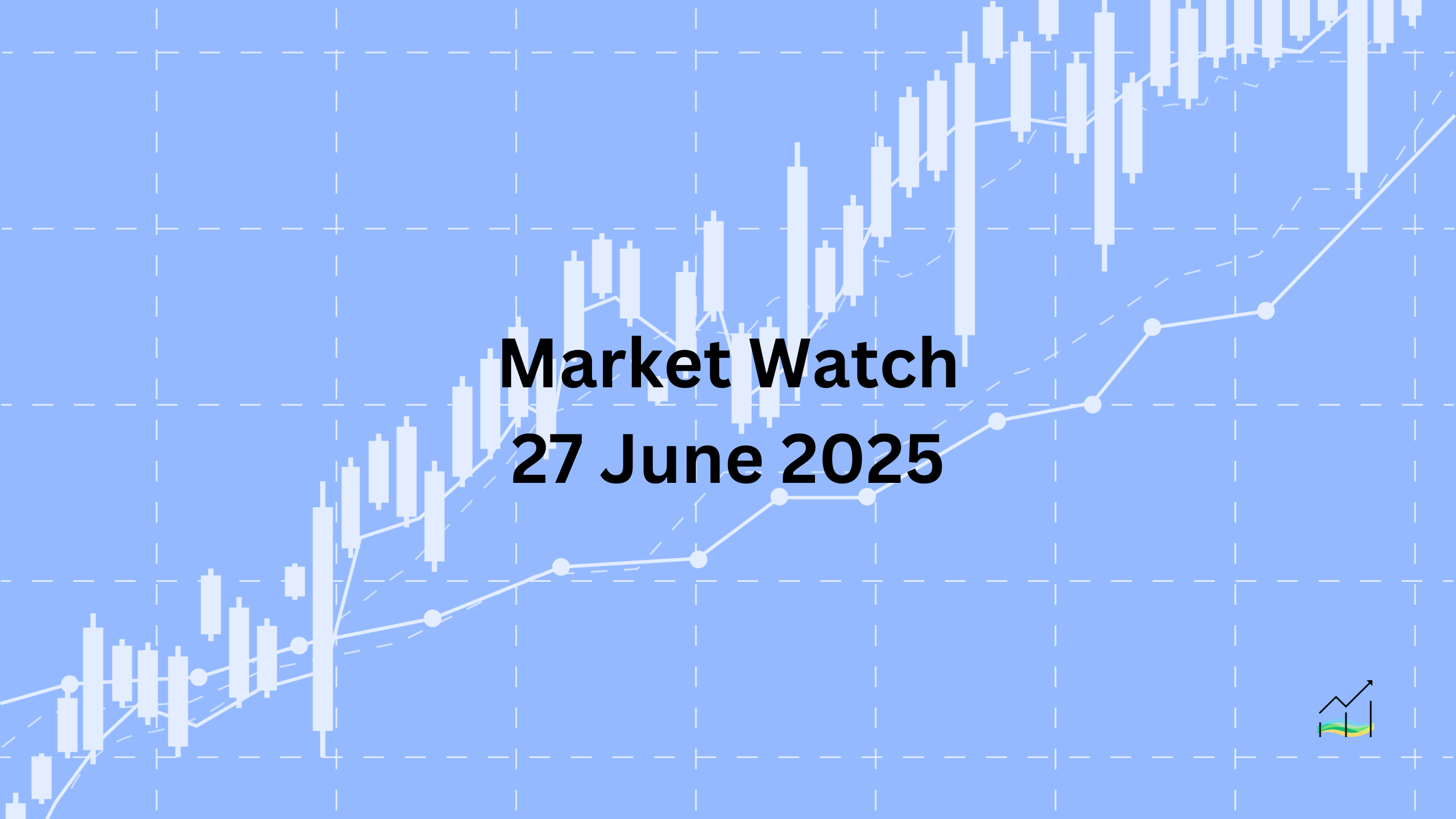27/06/2025 Week Ahead

Global Equities Climb as Dollar Struggles for Support
Key Takeaways:
- The US dollar steadied after sharp losses, though remains weak.
- Trade deals and tax relief measures offered limited support.
- Global equities advanced with Europe showing back-to-back gains.
- Bond yields rose modestly while gold touched new monthly lows.
- Oil prices held within recent trading ranges.
The US dollar steadied today after suffering deep losses in the previous session, falling to multiyear lows against the euro and sterling and to a decade low against the Swiss franc. Market sentiment was somewhat buoyed by reports of trade deals progressing, along with confirmed agreements involving China. Additional relief came from the United States securing an exemption from the OECD's Pillar 2 corporate tax reform, and the decision to abandon the so-called "revenge tax" under Section 899 of the budget proposal. There is also speculation that the postponement of reciprocal tariffs could be extended beyond the current July 9 deadline. Despite this stabilisation, the dollar has yet to gain any significant traction and remains near its recent lows.
Equity markets responded more optimistically. Most Asia Pacific indices moved higher, led by a gain of over 1% in Japanese stocks, while China, Hong Kong, and Australia lagged. In Europe, the Stoxx 600 rose close to 1%, with hopes of marking its first back-to-back advance in three weeks if momentum holds. US index futures posted moderate gains of around 0.2% to 0.3%. Benchmark government yields also inched higher. Japanese 10-year yields climbed to a weekly high near 1.43% with a two basis point increase. European yields edged up less than one basis point, enough to lift Germany’s 10-year Bund to a weekly high of approximately 2.57%. The US 10-year Treasury yield rose by about three basis points to 4.27%, though it remains roughly eight basis points lower on the week.
Meanwhile, gold prices slipped to a fresh monthly low around $3282, while oil markets stayed confined within familiar boundaries. August WTI continued to trade inside the ranges set earlier in the week, reflecting subdued momentum.
United States of America
Overview
The US dollar remains under significant pressure, struggling to recover despite developments in trade agreements and the proposed removal of the so-called “revenge tax” from the federal budget. The Dollar Index continues to hover near a three-year low around 97.00, having briefly reached higher levels earlier before retreating once more during European trading hours. Markets are focused on the upcoming release of the PCE deflator, with most economists expecting little surprise given previous CPI and PPI figures this month. Both headline and core measures are projected to rise by 0.1%, nudging annual rates slightly higher.
Beyond the inflation metrics, there is growing concern about weakening consumption. The first-quarter GDP revision showed consumer spending slowing from 1.2% to just 0.5%, and personal consumption in April rose only 0.2%, with a median forecast for May showing a further slowdown to 0.1%. Rising household debt stress, declining consumer confidence, and slower job growth have all contributed to a more fragile consumption outlook. Inflation-adjusted consumption through May has been running at half the pace seen in the same period of 2024. Against this backdrop, the futures market is pricing in roughly a 21% probability of a Federal Reserve rate cut in July, up from 16% a week ago, although lower than the 28% odds seen before public criticism of Chair Powell and speculation about his replacement surfaced.
Economic Drivers
- Lingering weakness in the dollar despite trade agreements and budget revisions.
- Market focus on PCE deflator data for inflation signals.
- Slowing consumer spending and weaker consumption data.
- Rising household debt stress and falling confidence levels.
- Moderation in job growth.
- Political tension surrounding Fed leadership and rate policy.
Data and Events
- 27 June 2025: PCE Price Index.
- 27 June 2025: UoM Consumer & Inflation.
Price Action
- Dollar Index pinned near three-year lows around 97.00.
- Brief recovery attempts towards 94.40 quickly faded.
- Market positioning remains cautious ahead of inflation data.
Key Points:
- Dollar struggles despite trade and tax developments.
- Consumption trends show clear slowdown.
- Market eyes PCE deflator as next inflation signal.
- Fed rate cut odds slightly higher, but uncertainty remains.
Canada
Overview
The Canadian dollar recorded its strongest daily advance of the month yesterday, gaining around 0.7% against the US dollar. After being rejected near CAD1.38 on Monday, the greenback retreated to below CAD1.3620, though it has since stabilised above CAD1.3625 and faces resistance around CAD1.3650. Despite this recent strength, the Canadian dollar remains one of the weaker G10 performers for the month, ahead only of the Japanese yen, which declined by approximately 0.2%. For the year to date, the Canadian dollar has climbed 5.4%, placing it at the bottom of the G10 rankings apart from the Australian dollar, which has gained nearly 5.8%. The year’s low for the USD/CAD pair was seen on June 16 around CAD1.3540.
Economic Drivers
- Canadian dollar supported by broad greenback weakness.
- Limited relative strength compared to other G10 currencies.
- Options-related flows influencing short-term price levels.
Data and Events
- 27 June 2025: GDP.
Price Action
- US dollar rejected near CAD1.38 and pulled back toward CAD1.3620.
- Stabilising above CAD1.3625 with resistance near CAD1.3650.
- Year’s low for USD/CAD near CAD1.3540 from mid-June.
Key Points:
- Canadian dollar showed strongest daily gain of the month.
- Remains one of the weaker G10 currencies for the month.
- Options expiry levels may influence near-term moves.
China
Overview
The US dollar reached a new yearly low against the offshore yuan yesterday, touching approximately CNH7.1525 before recovering above CNH7.17 in early European trading. Later in the day, the greenback softened again, testing the CNH7.16 level, and has since stabilised within yesterday’s trading range. The People’s Bank of China set the dollar’s reference rate today at CNY7.1627, broadly unchanged from the previous day and slightly lower than a week earlier.
The Hong Kong Monetary Authority has continued to tighten liquidity to defend the Hong Kong dollar peg, which may have indirectly eased upward pressure on the yuan by discouraging speculative short Hong Kong dollar and long yuan positions. On the economic front, China reported that industrial profits declined by 1.1% during the first five months of this year compared with the same period in 2024. Additionally, China confirmed its trade agreement with the United States, which includes the phased lifting of some US sanctions and a renewed supply of ethane, expected after the resumption of rare earth and magnet shipments.
Economic Drivers
- PBOC reference rate kept stable to support exchange rate stability.
- Intervention by the Hong Kong Monetary Authority tightening HKD liquidity, discouraging speculative trades.
- Weak industrial profit data highlighting continued manufacturing challenges.
- Trade agreement with the United States supporting confidence and potentially easing sanctions pressures.
Data and Events
No major economic releases are scheduled today.
Price Action
- Dollar fell to new yearly low near CNH7.1525 before recovering above CNH7.17.
- Later drifted back toward CNH7.16, stabilising within the previous day’s range.
- PBOC reference rate set at CNY7.1627, steady from yesterday.
Key Points:
- Yuan held firm after dollar weakness and stabilised within recent ranges.
- PBOC and HKMA measures helped manage exchange rate pressures.
- Industrial profits declined, reflecting continued economic headwinds.
- Trade agreement with the US offers some relief for future flows.
Europe
Overview
The euro rallied sharply yesterday, breaking through the $1.17 level with option-related demand seen as a key driver. The surge coincided with nearly six billion euros of options expiring between yesterday and July 1, according to DTCC data. The euro reached a high near $1.1745 during early European trading and approached that level again in the New York afternoon before losing momentum. Today it has remained steady, fluctuating within a narrow band around $1.17. If the euro breaks below $1.1680, short-term traders may pull back, potentially opening a path toward $1.1650, where further options of 2.1 billion euros are set to expire on Monday.
Economic data from the region added to market interest. France reported its harmonised June CPI rose 0.4%, double expectations, lifting the annual rate to 0.8% from 0.6%. Spain also reported a 0.6% monthly gain, with annual inflation slowing to 2.2% from 2.4%. Looking ahead, the eurozone's June CPI is forecast to rise 0.2% month-over-month, with the annual rate expected to hold steady at 1.9%. This inflation picture continues to shape market expectations for the region.
Economic Drivers
- Strong option-related demand boosting euro buying interest.
- Upcoming large option expiries influencing positioning.
- France and Spain showing mixed CPI outcomes, hinting at price pressures.
- Eurozone inflation expected to remain stable near target.
Data and Events
- 27 June 2025: French Prelim CPI.
- 27 June 2025: Spanish Flash CPI.
Price Action
- Euro surged through $1.17, peaking near $1.1745.
- Stabilised around $1.17 in a narrow 20-tick range.
- A break below $1.1680 could trigger a move toward $1.1650 with further option flows in play.
Key Points:
- Euro advanced strongly on option-related flows.
- French and Spanish inflation data came in above forecasts.
- Eurozone CPI expected to remain steady next week.
- Short-term momentum levels to watch remain close to $1.17.
Japan
Overview
The yen strengthened over recent sessions as the dollar retreated from levels near JPY146 on Wednesday to around JPY143.75 yesterday, largely driven by broad dollar weakness and declining US interest rates. The greenback settled below its 20-day moving average, around JPY144.55, for the first time in two weeks and has since traded quietly within the narrowest weekly range, between JPY144.20 and JPY144.80.
On the economic front, inflation data from Tokyo showed a softer trend. The headline consumer price index rose 3.1% year-over-year in June, easing from 3.4% in May. The core measure excluding fresh food also moderated to 3.1% from 3.6%, while the measure excluding fresh food and energy fell to 3.1% from 3.3%. These trends are expected to be reflected in national inflation figures as well. The market continues to see negligible chances of a rate hike at the end of the July Bank of Japan meeting, with some forecasts now pushing any possible increase into 2026.
Japan also released May retail sales data, which showed a surprise decline of 0.2% versus expectations for a 0.3% increase, following a 0.7% rise in April. Consumption in GDP terms has remained more stable than either government spending or private investment. Japan’s economy contracted at an annualised rate of 0.2% in the first quarter and is estimated to have improved only slightly in the second quarter. In labour data, May’s unemployment rate held steady at 2.5%, while the job-to-applicant ratio declined to 1.24 from 1.26, its lowest reading since early 2022.
Economic Drivers
- Broad dollar weakness supporting yen gains.
- Softer Tokyo inflation data suggesting easing price pressures.
- Weak retail sales data highlighting fragile household spending.
- Stable unemployment but reduced job-to-applicant ratio pointing to a softer labour market.
- Low expectations for a near-term Bank of Japan rate hike.
Data and Events
- 27 June 2025: Tokyo Core CPI.
- 27 June 2025: Unemployment Rate.
- 27 June 2025: Retail Sales.
Price Action
- Dollar fell from near JPY146 to JPY143.75 with shallow bounces.
- Settled below the 20-day moving average for the first time in two weeks.
- Trading within a tight range between JPY144.20 and JPY144.80.
Key Points:
- Yen strengthened as dollar and US yields weakened.
- Tokyo inflation eased more than expected.
- Retail sales data disappointed, reflecting weak domestic demand.
- Labour market indicators showed mild deterioration.
© 2025 SKONE Enterprise (003319453-V). All rights reserved.
The content on this site is for informational purposes only and does not constitute financial advice.


